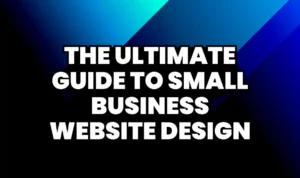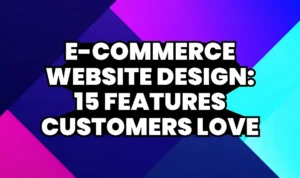Introduction
Increasing website conversions is a top priority for every business. Implementing website design hacks for conversions can significantly improve user engagement, drive sales, and maximize ROI. Studies show that even small design improvements can increase conversions by up to 50%.
Whether you run an e-commerce store, a service-based business, or a content platform, mastering these design hacks is crucial. In this guide, we’ll explore seven actionable website design hacks for conversions that you can implement immediately. These strategies focus on user experience (UX), visual hierarchy, content placement, and psychological triggers, ensuring your website not only looks appealing but also converts visitors efficiently.

1. Simplify Navigation
A cluttered menu can frustrate visitors, leading to high bounce rates. One of the most effective website design hacks for conversions is simplifying navigation.
- Use clear, descriptive labels for menus.
- Limit primary menu items to 5–7 options.
- Include a sticky menu so users can access navigation anytime.
A website with intuitive navigation keeps users engaged longer, increasing the chances of conversions. For inspiration, you can check how we applied smart navigation in our case studies.
2. Optimize Call-to-Action (CTA) Placement
CTAs are the backbone of conversions. Effective website design hacks for conversions include:
- Placing CTAs above the fold for immediate visibility.
- Using contrasting colors to make them stand out.
- Testing different CTA text to see which resonates best.
Instead of a generic “Submit,” try action-driven phrases like “Get My Free Consultation” or “Claim Your Discount.” Our team has helped numerous clients enhance CTA performance—see our consultation page for examples.
3. Use White Space Strategically
White space, or negative space, is a subtle but powerful website design hack for conversions. It reduces visual clutter, helps users focus on key elements, and improves readability.
- Surround CTAs with ample white space.
- Avoid cramming too many elements in one section.
- Use spacing to guide the user’s eye naturally through the page.
Websites with well-structured white space are perceived as professional and trustworthy, boosting user confidence and conversion rates.
4. Improve Page Load Speed
Website speed directly affects conversions. A slow-loading site frustrates users, increasing bounce rates and reducing revenue. Implementing website design hacks for conversions includes:
- Compressing images without losing quality.
- Minimizing CSS, JavaScript, and HTML files.
- Using reliable hosting solutions like Dronahost Hosting for optimal performance.
Even a one-second delay in page load can reduce conversions by up to 7%, according to Google.
5. Leverage Social Proof
Social proof—reviews, testimonials, and user-generated content—is a proven website design hack for conversions. People are more likely to trust a product or service endorsed by others.
- Include customer testimonials with photos.
- Display recent purchases or user reviews.
- Highlight partnerships or certifications.
Adding social proof builds trust and encourages hesitant visitors to convert. Our portfolio demonstrates several examples of effective social proof integration.
6. Mobile-First Design
With mobile traffic surpassing desktop, mobile optimization is essential. Mobile-responsive design is one of the most impactful website design hacks for conversions:
- Ensure CTAs and buttons are easily clickable on small screens.
- Optimize forms for mobile entry.
- Use responsive images and layouts for a seamless user experience.
A mobile-first design reduces friction, ensuring visitors have a smooth experience across devices.
7. A/B Testing for Continuous Improvement
Even with best practices, continuous optimization is key. A/B testing is a smart website design hack for conversions:
- Test different headlines, images, and CTAs.
- Compare layouts and content placement.
- Use analytics to identify what drives the most conversions.
Experimenting with multiple versions allows you to fine-tune your website design for maximum impact. For tools and hosting support, check Dronahost Hosting to ensure your site performs flawlessly.
Part 2 – Advanced Design Hacks to Boost Conversions
8. Leverage Color Psychology
Color influences human emotions and behavior, making it one of the most effective website design hacks for conversions. Choosing the right colors for your CTAs, buttons, and banners can dramatically improve engagement.
- Red and orange: Create urgency and encourage action.
- Blue: Conveys trust, professionalism, and reliability.
- Green: Associated with growth, success, and “go” signals.
Always maintain a balance between brand colors and usability. Using too many bright colors can distract users, while muted colors may fail to attract attention.
9. Optimize Typography
Typography affects readability, user perception, and trust. Optimizing fonts is a critical website design hack for conversions:
- Use 1–2 main font families for a clean look.
- Maintain proper font size (16–18px for body text) for readability.
- Highlight headings, CTAs, and key messages with bolder fonts.
Readable typography ensures visitors can quickly scan and understand your content, reducing friction in the conversion funnel.
10. Incorporate Visual Hierarchy
Visual hierarchy guides users to the most important parts of a webpage. Implementing it is another key website design hack for conversions:
- Position primary CTAs and offers prominently.
- Use larger images or bold text for critical elements.
- Utilize spacing and alignment to separate sections clearly.
A strong visual hierarchy ensures users notice and interact with high-priority actions, boosting conversions.
11. Build Trust with Security Signals
Security is a major factor in converting online users. Displaying trust signals is a subtle but effective website design hack for conversions:
- Use HTTPS and secure payment gateways.
- Display SSL badges and verified logos.
- Include guarantees like “30-day money-back” or “Free Returns.”
These signals reassure visitors, reducing hesitation and increasing purchase confidence.
12. Utilize Persuasive Content
Copywriting is an integral part of design. Well-crafted content works alongside website design hacks for conversions to nudge visitors toward action:
- Use concise, benefit-focused headlines.
- Highlight unique selling propositions (USPs).
- Include clear, action-oriented microcopy near buttons and forms.
Engaging content coupled with strong design creates a persuasive, conversion-driven experience.
13. Reduce Form Friction
Forms are common conversion points, but long or complicated forms can drive users away. Reducing form friction is a high-impact website design hack for conversions:
- Limit form fields to essentials only.
- Include autofill and inline validation to improve usability.
- Add progress indicators for multi-step forms.
A smooth, user-friendly form can significantly increase lead generation and sales.
14. Incorporate Exit-Intent Popups
While popups are often seen as intrusive, exit-intent popups can be highly effective when designed well:
- Trigger the popup when the user moves to exit the page.
- Offer discounts, free trials, or valuable content.
- Keep the design clean and visually appealing.
Exit-intent popups act as a final nudge to convert abandoning visitors into customers.
15. Continuous Analytics and Improvement
Finally, consistent monitoring and optimization are crucial. Using data to guide design decisions ensures your website design hacks for conversions stay effective:
- Track user behavior with tools like Google Analytics or Hotjar.
- Analyze heatmaps to understand where users click most.
- Test new designs periodically and iterate based on performance.
Websites that continually evolve based on user behavior consistently achieve higher conversion rates.
Conclusion
Implementing website design hacks for conversions is essential for maximizing your online success. From simplified navigation and optimized CTAs to color psychology and trust signals, each tweak can make a measurable impact on user engagement and sales.
Businesses that prioritize conversion-driven design see up to 50% improvements in sales, lead generation, and overall ROI. By combining aesthetics with usability, persuasive content, and data-driven strategies, you create a website that not only looks great but also converts effectively.
At DevsKing, our team specializes in implementing these strategies for businesses across industries. Explore our portfolio or request a consultation to see how we can help you boost your website conversions.
For reliable hosting that ensures speed and performance, we recommend Dronahost Hosting, ensuring your optimized website delivers a seamless user experience.
FAQs
- What are website design hacks for conversions?
Techniques and strategies in web design that improve user engagement and increase conversion rates. - How much can these design hacks improve conversions?
Implementing these strategies can boost conversions by up to 50%, depending on the website and industry. - Are these hacks suitable for all websites?
Yes, whether it’s e-commerce, service-based, or content-driven sites, these hacks apply universally. - Do I need a designer to implement these hacks?
Professional designers can optimize execution, but many hacks can be applied with CMS tools or plugins. - Does page speed affect conversions?
Absolutely. Faster websites reduce bounce rates and increase user satisfaction, directly impacting conversions. - How does color influence conversion rates?
Colors trigger emotions and actions; strategic use can encourage clicks and purchases. - Why is mobile optimization important for conversions?
Most users browse and buy on mobile. Mobile-friendly design ensures a smooth experience, increasing conversions. - What is visual hierarchy and why does it matter?
It organizes page elements by importance, guiding users to key actions and improving conversions. - Can trust signals really increase sales?
Yes, badges, reviews, and guarantees reassure users and reduce purchase hesitation. - Should I continuously test my website design?
Yes, A/B testing and analytics help identify high-performing designs, ensuring sustained conversion growth.






